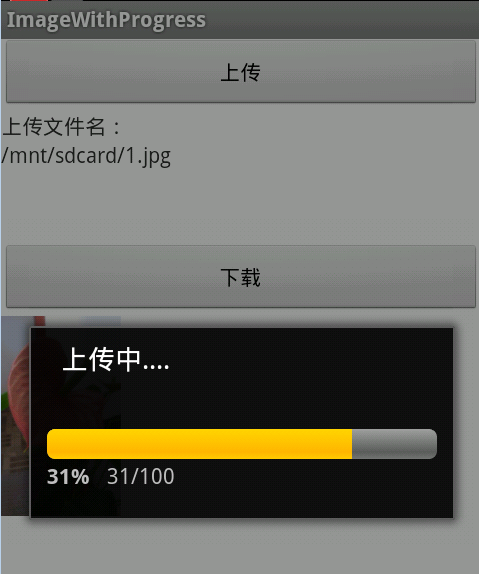上一篇文章Android使用HttpClient实现下载,并监控进度,本文继续讲解实现上传进度监控,原理其实一样,只不过这次重载的是FilterOutputStream,服务器端使用PHP进行文件的接收。好记性不如烂笔头,方便以后查阅,不当之处,还请指正。
服务器端PHP
废话不多说,直接上代码:
<?php
$target_path = "./tmp/";//接收文件目录
$target_path = $target_path.($_FILES['file']['name']);
$target_path = iconv("UTF-8","gb2312", $target_path);
if(move_uploaded_file($_FILES['file']['tmp_name'], $target_path)) {
echo "The file ".( $_FILES['file']['name'])." has been uploaded.";
}else{
echo "There was an error uploading the file, please try again! Error Code: ".$_FILES['file']['error'];
}
?>
监控进度实现
首先定义监听器接口,这和上文中是一样的,如下所示:
/**
* 进度监听器接口
*/
public interface ProgressListener {
public void transferred(long transferedBytes);
}
实现监控进度的关键部分就在于记录已传输字节数,所以我们需重载FilterOutputStream,重写其中的关键方法,实现进度监听的功能,如下所示,本例中首先重载的是HttpEntityWrapper,顾名思义,就是将需发送的HttpEntity打包,以便计算总字节数,代码如下:
/**
* ProgressOutHttpEntity:输出流(OutputStream)时记录已发送字节数
*
* @author Cow
*
*/
public class ProgressOutHttpEntity extends HttpEntityWrapper {
private final ProgressListener listener;
public ProgressOutHttpEntity(final HttpEntity entity,
final ProgressListener listener) {
super(entity);
this.listener = listener;
}
public static class CountingOutputStream extends FilterOutputStream {
private final ProgressListener listener;
private long transferred;
CountingOutputStream(final OutputStream out,
final ProgressListener listener) {
super(out);
this.listener = listener;
this.transferred = 0;
}
@Override
public void write(final byte[] b, final int off, final int len)
throws IOException {
// NO, double-counting, as super.write(byte[], int, int)
// delegates to write(int).
// super.write(b, off, len);
out.write(b, off, len);
this.transferred += len;
this.listener.transferred(this.transferred);
}
@Override
public void write(final int b) throws IOException {
out.write(b);
this.transferred++;
this.listener.transferred(this.transferred);
}
}
@Override
public void writeTo(final OutputStream out) throws IOException {
this.wrappedEntity.writeTo(out instanceof CountingOutputStream ? out
: new CountingOutputStream(out, this.listener));
}
}
最后就是使用上述实现的类和Httpclient进行上传并显示进度的功能,非常简单,代码如下,使用AsyncTask异步上传。
public class FileUploadAsyncTask extends AsyncTask<File, Integer, String> {
private String url = "http://192.168.83.213/receive_file.php";
private Context context;
private ProgressDialog pd;
private long totalSize;
public FileUploadAsyncTask(Context context) {
this.context = context;
}
@Override
protected void onPreExecute() {
pd = new ProgressDialog(context);
pd.setProgressStyle(ProgressDialog.STYLE_HORIZONTAL);
pd.setMessage("上传中....");
pd.setCancelable(false);
pd.show();
}
@Override
protected String doInBackground(File... params) {
// 保存需上传文件信息
MultipartEntityBuilder entitys = MultipartEntityBuilder.create();
entitys.setMode(HttpMultipartMode.BROWSER_COMPATIBLE);
entitys.setCharset(Charset.forName(HTTP.UTF_8));
File file = params[0];
entitys.addPart("file", new FileBody(file));
HttpEntity httpEntity = entitys.build();
totalSize = httpEntity.getContentLength();
ProgressOutHttpEntity progressHttpEntity = new ProgressOutHttpEntity(
httpEntity, new ProgressListener() {
@Override
public void transferred(long transferedBytes) {
publishProgress((int) (100 * transferedBytes / totalSize));
}
});
return uploadFile(url, progressHttpEntity);
}
@Override
protected void onProgressUpdate(Integer... progress) {
pd.setProgress((int) (progress[0]));
}
@Override
protected void onPostExecute(String result) {
pd.dismiss();
Toast.makeText(context, result, Toast.LENGTH_SHORT).show();
}
/**
* 上传文件到服务器
*
* @param url
* 服务器地址
* @param entity
* 文件
* @return
*/
public static String uploadFile(String url, ProgressOutHttpEntity entity) {
HttpClient httpClient = new DefaultHttpClient();
httpClient.getParams().setParameter(
CoreProtocolPNames.PROTOCOL_VERSION, HttpVersion.HTTP_1_1);
// 设置连接超时时间
httpClient.getParams().setParameter(
CoreConnectionPNames.CONNECTION_TIMEOUT, 5000);
HttpPost httpPost = new HttpPost(url);
httpPost.setEntity(entity);
try {
HttpResponse httpResponse = httpClient.execute(httpPost);
if (httpResponse.getStatusLine().getStatusCode() == HttpStatus.SC_OK) {
return "文件上传成功";
}
} catch (ClientProtocolException e) {
e.printStackTrace();
} catch (ConnectTimeoutException e) {
e.printStackTrace();
} catch (Exception e) {
e.printStackTrace();
} finally {
if (httpClient != null && httpClient.getConnectionManager() != null) {
httpClient.getConnectionManager().shutdown();
}
}
return "文件上传失败";
}
}
最后的最后,上传效果图如下:

有疑问或者觉得不对的地方还请指正,谢谢。
Comments